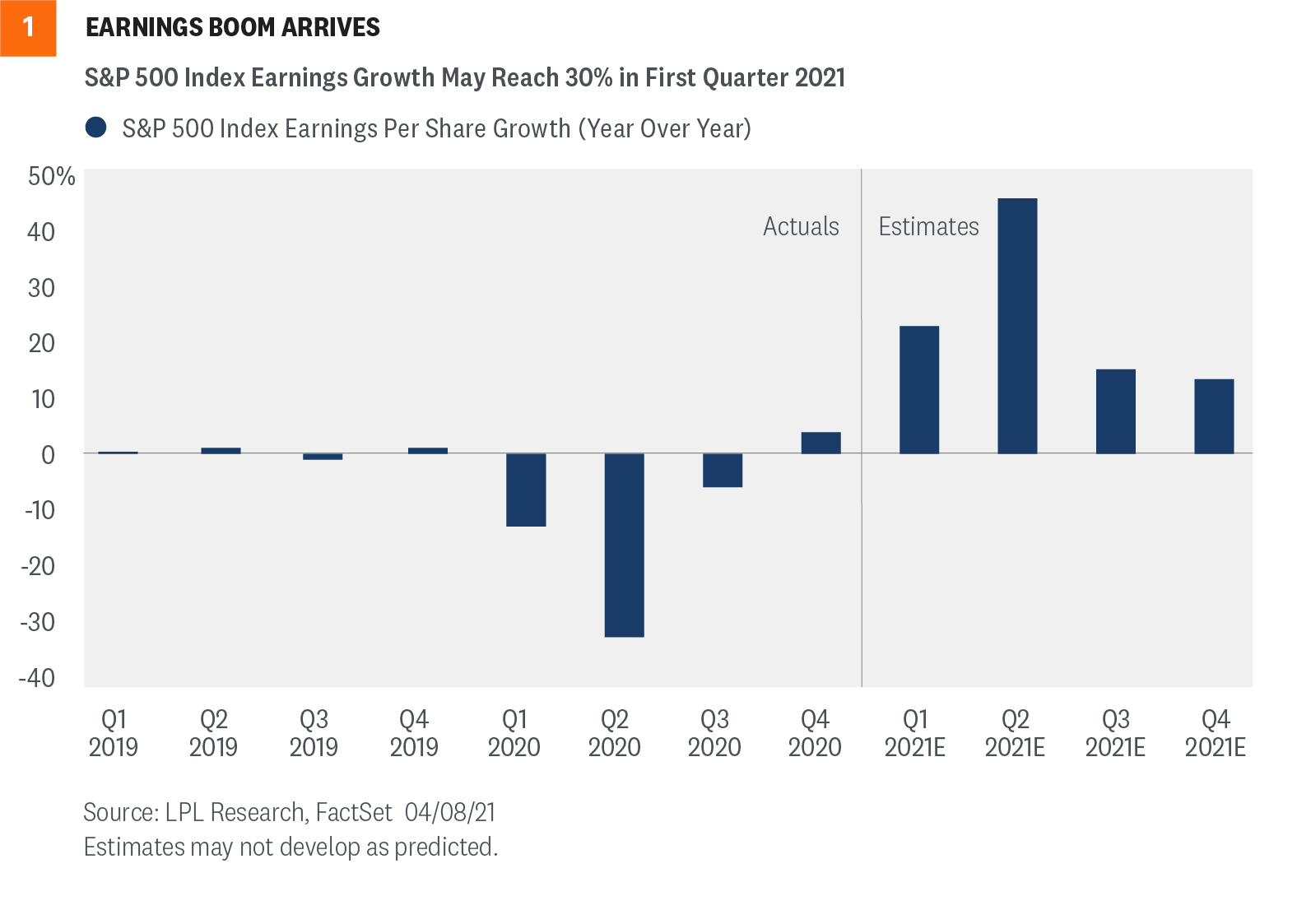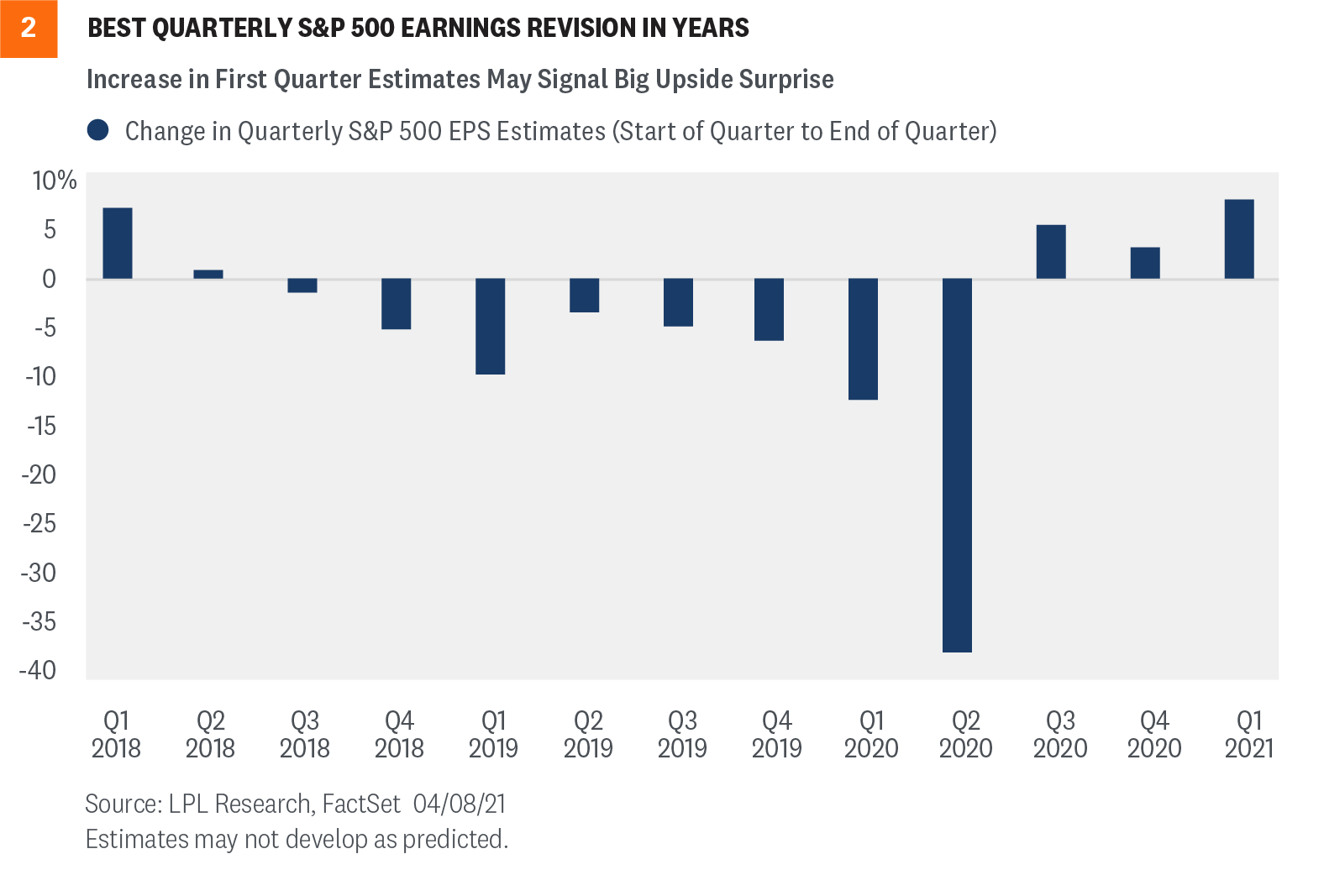The outstanding fourth-quarter earnings season we had in 2020 is a tough act to follow, but 2021’s first quarter has the makings of another potentially great earnings season. The reopening of the economy continues to move forward, and corporate America has done an excellent job managing through the pandemic. In fact, it won’t take much of an upside surprise for year-over-year S&P 500 Index earnings growth to reach 30% this quarter. The 2021 earnings boom is here.
Poised For Another Strong Earnings Season
Coming into fourth-quarter earnings season, investors had plenty of reasons to expect companies would deliver better-than-expected results—and they did. Virtually no one—ourselves included—expected S&P 500 companies to grow earnings in aggregate during fourth quarter 2020, especially considering fourth quarter 2019 was over before the pandemic began in the U.S. Well, corporate America delivered 4% year-over-year earnings growth in the fourth quarter of 2020 despite the difficult year-over-year comparison, as shown in [Figure 1], which was about 13 percentage points better than the consensus estimate when the fourth quarter began on October 1, 2020.

The second piece of good news is that most of the factors that contributed to such a big upside surprise last quarter remain in place today, including the following:
Stronger economic growth. Bloomberg’s consensus expectation for first-quarter U.S. economic growth, measured by gross domestic product (GDP), increased from 2.5% to 4.7% during the first quarter. The raised forecast, which would represent a modest improvement from the 4.3% GDP growth rate in the fourth quarter, may still be too low given the accelerating vaccine rollout and the latest $1.9 trillion fiscal stimulus package.
Rising estimates. The consensus estimate for first-quarter earnings growth has risen by 6% since January 1, 2021, the most recorded by FactSet since it began tracking earnings data in 2002 and slightly ahead of the 5.4% increase in S&P 500 earnings in the first quarter of 2018, when corporate taxes were cut. Higher estimates tend to signal companies will be able to deliver upside, potentially more than the typical several percentage points. Over the past 20 years, estimates have been reduced by an average of about 3% quarterly. The past 17 quarters are shown in [Figure 2].

Manufacturing is booming. Last quarter we highlighted the Institute for Supply Management (ISM) manufacturing index level of 60.7 in December 2020 as a reason for earnings optimism because of the connection between manufacturers’ spending plans and corporate profits. The reading for March 2021 reached 64.7, the highest level in over 35 years.
How Much Upside Could We See?
We think we’re set up for very strong earnings growth and a lot of upside surprises this earnings season. However, the magnitude of last quarter’s beat, the big increase in the consensus estimate for this year, and the latest rally in the U.S. dollar all suggest that double-digit upside may be too much to ask for this quarter.
But after seeing corporate America navigate the pandemic so effectively the past three quarters, maybe that much upside isn’t completely out of the question. An improving rate environment for financials and better commodity price environment for the resource sectors are a couple of potential catalysts to watch for upside.
As Always, Guidance is Key
We raised our S&P 500 earnings per share (EPS) estimate for 2021 last week from $170 to a range of $175—$177.50 because of our improved economic outlook and additional fiscal stimulus. FactSet consensus stands at $176.60 currently, or about 26% above 2020 levels. The main question we will be trying to answer this earnings season as we hear from companies is whether consensus is still too low.
One reason to think estimates might be too low is that GDP plus inflation has historically correlated to corporate revenue. While our recently raised U.S. GDP growth forecast is now 6.25%—6.75%, we acknowledge that if the re-opening progresses as we hope it will as more people are vaccinated, the U.S. economy could grow faster than that and drive stronger revenue growth. FactSet’s consensus for S&P 500 revenue growth in 2021 is 10%.
Another reason to think estimates may be too low is that it is early in the economic expansion. When the economy is still emerging from recession, analysts tend to be too conservative. The uncertainty during those periods also causes corporate management teams to provide cautious outlooks that are often exceeded. This dynamic was at work during the past three quarters and may still be in play.
Some Earnings Headwinds To Consider
The earnings outlook is really good right now, but there are some reasons to think that perhaps estimates have caught up to reality and that the positive revisions may soon run out of steam. First, the battle against COVID-19 isn’t over, which carries risk. Second, as the labor market tightens over the course of the year, we may see more upward pressure on wages, which could be a headwind for further profit margin improvement. Third, though not our expectation, recent strength in the U.S. dollar could continue, which would trim international earnings for U.S.-based multinationals.
Finally, any corporate tax rate increases will likely take a chunk out of earnings, though not until 2022. We could see a high single-digit percentage earnings hit for the S&P 500 next year if corporate taxes are increased, making our 2022 S&P 500 EPS forecast of $195 tougher to reach. With valuations elevated, it’s going to be important to the stock market for these earnings to come through.
Reiterating Positive Stock Market Outlook
Our confidence in the U.S. economic recovery continues to grow, bolstered by vaccine distribution, and fiscal and monetary stimulus. We anticipate a strong earnings rebound will enable stocks to grow into their elevated valuations, even if interest rates move a bit higher from here. That said, we acknowledge that after a 10% rally in the S&P 500 Index this year with limited volatility, and an 84% move off the March 23, 2020, low in a little over a year, a pullback would be totally normal. A lot of good news may already be priced in. COVID-19 variants remain a risk. Interest rates could move sharply higher and put pressure on stock valuations. U.S.-China tensions may escalate.
We continue to recommend an overweight to equities and underweight to fixed income relative to investors’ targets despite the strong year-to-date rally, as appropriate. For now, we are maintaining our year-end 2021 S&P 500 Index fair value target range of 4,050–4,100, based on a price-to-earnings (PE) multiple near 21 and our 2022 earnings forecast of $195 per share. Depending on the paths of economic growth, fiscal and monetary policy, corporate profits, and interest rates, we may consider a higher target. We recommend tactical investors maintain equity allocations despite recent strength, as even modest equity returns over the balance of the year bring attractive relative-return potential compared with high-quality bonds and cash.
IMPORTANT DISCLOSURES
This material is for general information only and is not intended to provide specific advice or recommendations for any individual. There is no assurance that the views or strategies discussed are suitable for all investors or will yield positive outcomes. Investing involves risks including possible loss of principal. Any economic forecasts set forth may not develop as predicted and are subject to change.
References to markets, asset classes, and sectors are generally regarding the corresponding market index. Indexes are unmanaged statistical composites and cannot be invested into directly. Index performance is not indicative of the performance of any investment and do not reflect fees, expenses, or sales charges. All performance referenced is historical and is no guarantee of future results.
Any company names noted herein are for educational purposes only and not an indication of trading intent or a solicitation of their products or services. LPL Financial doesn’t provide research on individual equities.
All information is believed to be from reliable sources; however, LPL Financial makes no representation as to its completeness or accuracy.
US Treasuries may be considered “safe haven” investments but do carry some degree of risk including interest rate, credit, and market risk. Bonds are subject to market and interest rate risk if sold prior to maturity. Bond values will decline as interest rates rise and bonds are subject to availability and change in price.
The Standard & Poor’s 500 Index (S&P500) is a capitalization-weighted index of 500 stocks designed to measure performance of the broad domestic economy through changes in the aggregate market value of 500 stocks representing all major industries.
The PE ratio (price-to-earnings ratio) is a measure of the price paid for a share relative to the annual net income or profit earned by the firm per share. It is a financial ratio used for valuation: a higher PE ratio means that investors are paying more for each unit of net income, so the stock is more expensive compared to one with lower PE ratio.
Earnings per share (EPS) is the portion of a company’s profit allocated to each outstanding share of common stock. EPS serves as an indicator of a company’s profitability. Earnings per share is generally considered to be the single most important variable in determining a share’s price. It is also a major component used to calculate the price-to-earnings valuation ratio.
All index data from FactSet.
Please read the full Outlook 2021: Powering Forward publication for additional description and disclosure.
This research material has been prepared by LPL Financial LLC.
Securities and advisory services offered through LPL Financial (LPL), a registered investment advisor and broker-dealer (member FINRA/SIPC). Insurance products are offered through LPL or its licensed affiliates. To the extent you are receiving investment advice from a separately registered independent investment advisor that is not an LPL affiliate, please note LPL makes no representation with respect to such entity.
| Not Insured by FDIC/NCUA or Any Other Government Agency | Not Bank/Credit Union Guaranteed | Not Bank/Credit Union Deposits or Obligations | May Lose Value |
RES-705650-0421 | For Public Use | Tracking # 1-05132200 (Exp. 04/22)